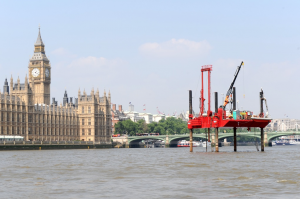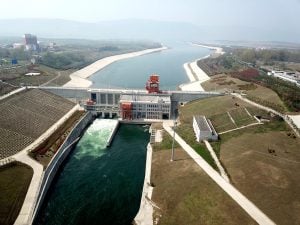Water can seem endless: it covers 70% of the earth’s surface, flows in rivers and falls from the sky. Yet climate change is making the world’s water supply unreliable. As water scarcity grows, local campaigns across the globe are rolling back corporate ownership and challenging water privatisation, in a bid to regain control over our most vital resource.
Only 2.5% of the world’s water is freshwater and safe for consumption. Sources are often difficult to access; hidden in remote glaciers or deep underground. Climate change has brought droughts in some places and floods in others, making freshwater supplies more difficult to manage. Heatwaves have forced some cities to drill deeper for groundwater or desalinate sea water. In flooded regions, freshwater has increased, but heavier rainfall has made it more difficult to store.
As weather extremes bring new challenges for water management, industry and urbanisation are aggravating demand. The United Nations estimates that during the last century water use exceeded the rate of population growth. Agriculture now accounts for 70% of freshwater usage. With more people migrating to cities, existing infrastructure is creaking. Close to 27% of urban-dwellers in cities in the developing world lack access to piped water at home.
These global trends create regional problems. The number of people living in water stressed areas, where freshwater is limited during part or all of the year, is set to rise. Water inequalities often map onto existing social fractures, with poor infrastructure leaving urban peripheries disconnected, and scarcity kindling water-related conflicts. In these uncertain conditions, the question of who is best placed to manage water is crucial.
The promise of privatisation
At the same time, scarcity has created opportunities for profit. Water and sanitation has become a thriving industry dominated by multinationals like Veolia and Suez.
Willem Buiter, chief economist at investment bank Citigroup, described water as an “asset class” whose importance will eventually outstrip oil, copper and precious metals. Most major banks now have investment funds specifically targeted at the water industry, writes activist Maude Barlow.
England was the first country to sell off its water system in 1989, but privatisation remains politically controversial. The process typically involves municipal authorities leasing water provision to private companies in a public-private partnership. As Eduardo Araral, a professor of water policy at the Lee Kuan Yew School of Public Policy in Singapore writes, privatisation advocates argue this is worthwhile for two reasons.
First, the private sector delivers services more efficiently. In England, politicians expected market competition to hasten improvements to services and bring down costs. The second argument is fiscal. In the developing world, states struggle to raise finance for infrastructure projects, but ceding water provision to the private sector attracts inward investment.
From the 1990s onwards, the World Bank founded policies on this wisdom. In conjunction with the International Monetary Fund, it gave loans to developing countries on condition that they privatised utilities.
In countries such as Bolivia, the idea was that water privatisation would plug gaps left by the state. In the city of Cochabamba, for example, the World Bank wrote in 1999 that “poor governments are often too plagued by local corruption and too ill equipped” to manage their water supplies.
Clear costs, few benefits
But evidence shows governments have been overly optimistic about the benefits of selling up. In England, the average household water bill has risen by 40% above inflation since privatisation in 1989. And in the majority of privatisation cases, companies still rely on public funds. A study by the Public Services International Research Unit found companies received nearly 500 million euros from the European Bank for Reconstruction and Development from 1991-2012.
Thames Water, the company responsible for London’s water supply, embodies this reliance on public money. When asked to finance a new mega sewer in 2012, the company claimed it was too burdened by debt to afford it, despite paying millions of pounds in dividends to shareholders and executives. Instead, consumers will pay for the new sewer through higher water bills, with the state acting as guarantor in case the project has financial difficulties.
Meera Karunananthan, director of Canadian pressure group the Blue Planet Project, calls this the “socialisation of risk and privatisation of profits”, where companies extract profits while relying on the state to shoulder financial risk.
Infrastructure investment has a murkier record in the developing world. Despite assurances that companies would bring much-needed investment, most have only been willing to invest in middle income countries where risks are lower. A study by researchers Antonio Estache and Martin Rossi in 2002 found the majority of investment in private water provision occurred in middle-income countries like China (50%), rather than low income countries (18%) where needs are greatest.
There is a pereceived wisdom that developing countries can’t finance projects without private sector involvement. However, private companies rely on the same sources of investment that are available to governments — including donors, commercial and development banks — suggesting that privatisation is as much about political desire as economic necessity.
As David Hall, a researcher at the Public Services International Research Unit puts it, “when the private sector moves into water systems any loans they take out have to be guaranteed by governments – so the credit rating and viability is the same as the credit rating of the country”.
Back to public management
Public opinion about privatisation is shifting. Ellen Lees, head of campaigns at UK pressure group We Own It, notes that 2018 is “the first time there’s been a campaign for publicly owned water in the UK in twenty years”.
When surveyed by the Legatum Institute, an educational charity, in 2017, 83% of people in the UK were in favour of water nationalisation. The Transnational Institute, a campaigning organisation in the Netherlands, found that cities with public water supplies tend to enjoy increased quality and lower bills. It estimates that 266 cities globally have remunicipalised water systems.
“This is a global trend”, Lees says, adding that England risks “being left behind”.
Remunicipalisation differs from nationalisation. The latter is orchestrated by a centralised state, while the former is typically undertaken by regions or cities, with water and sanitation falling under municipal jurisdiction. Where nationalisation has a whiff of overweening state bureaucracy, remunicipalisation devolves ownership to democratically elected regional authorities.
This participation in municipal ownership can also lead to wider political involvement. In Paris, where Suez and Veolia transferred water services to the publicly owned Eau de Paris in 2008, trade unions, environmentalists and tenants associations are all represented at board level, and meetings are open to the general public.
Other municipalities are next.
When citizens platform Barcelona en Comú crowdsourced its manifesto for city elections in 2015, remunicipalising water came top of the list. Campaigning group Aiuga és Vida found water rates set by Agbar-Suez were 91.7% more expensive than those in neighbouring Spanish towns where water is publicly managed. The city’s water has become a political battleground, with Agbar-Suez allegedly hiring spies to pose as activists and infiltrate water campaign groups earlier this year.
But there’s still the question of what to do when the public sector fails. In Nigeria, for example, up to 90% of water is lost through leaks and theft. Lagos State has long planned to sell off water services, much to the anger of local NGOs. However, David Hall argues that tackling the underlying causes of public sector failure, such as corruption, is a better approach. Allowing corrupt politicians to pocket the sale of public utilities is “highly unlikely” to improve the situation of Lagos State, he says. Surveying the mixed legacy of water privatisation elsewhere, he may be right.
This article is the second in a three-part series examining water scarcity and water management in a global context to mark World Water Week 2018 (26th – 31st August). Part one can be read here.






![Only a little grass and a few animals grazing near the Deosai National Park [image by: Amar Guriro]](https://dialogue.earth/content/uploads/2018/09/16-B-300x200.jpg)

![Sharada Bogati of Bidur-9 cleaning dishes beside her home. Unlike many neighbourhoods in Bidur, families in her neighbourhood get enough water for their daily use and also for vegetable farming [image by: Bhrikuti Rai]](https://dialogue.earth/content/uploads/2018/08/MG_9723-e1595342190272-300x200.jpg)